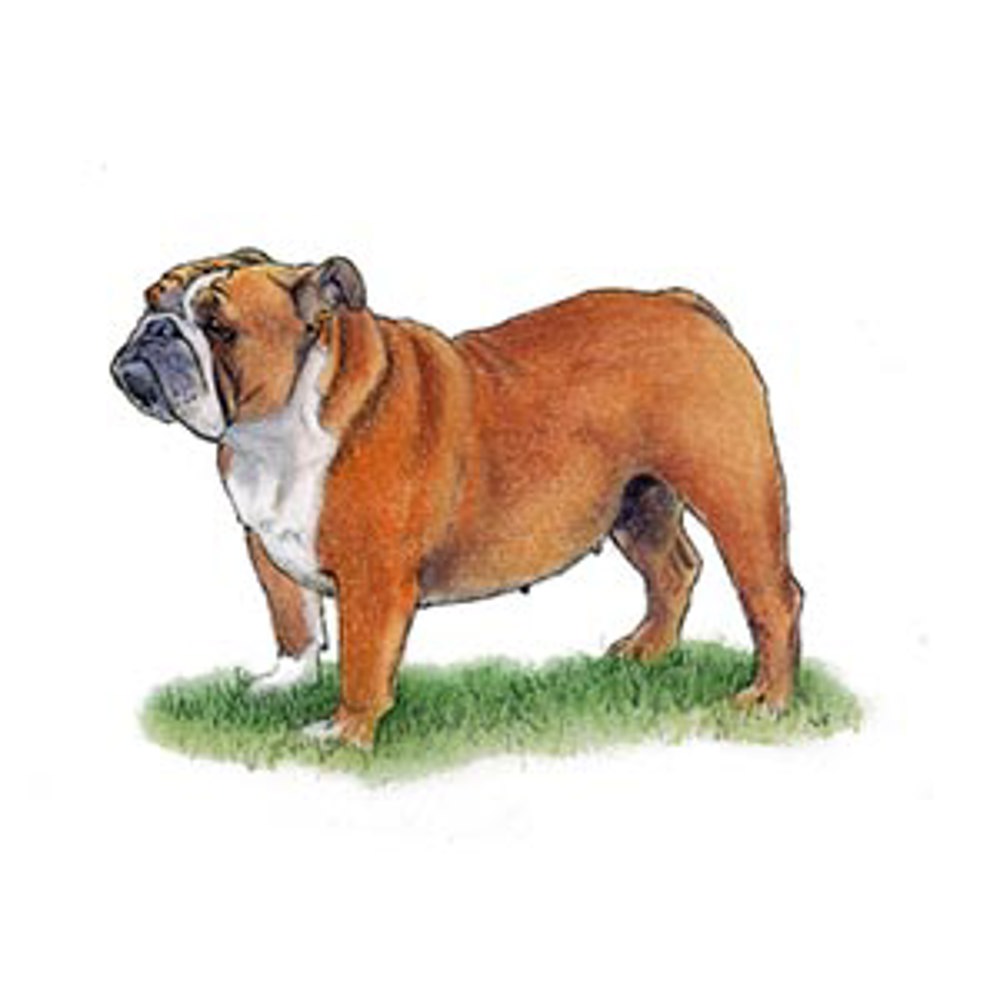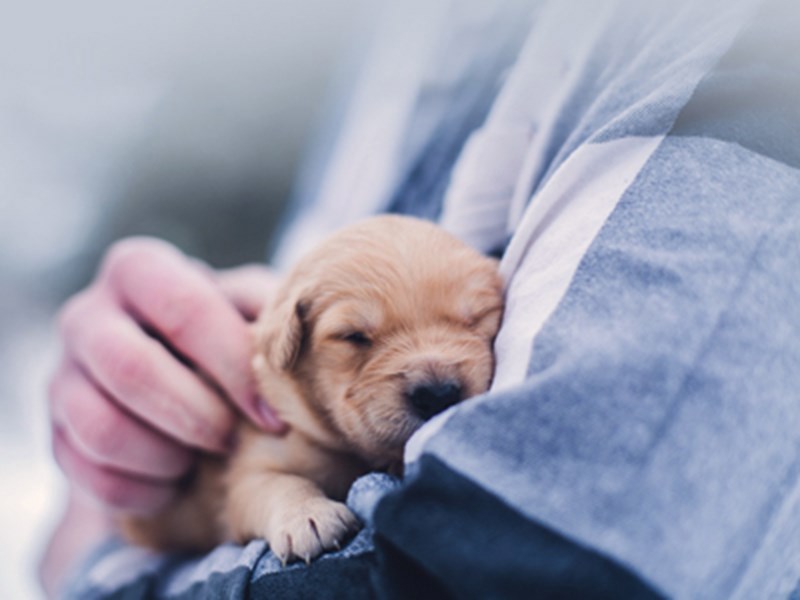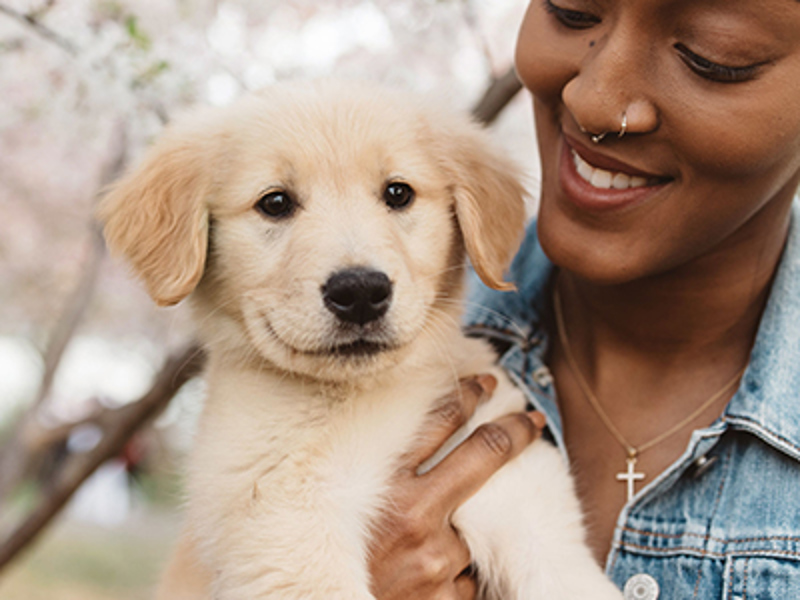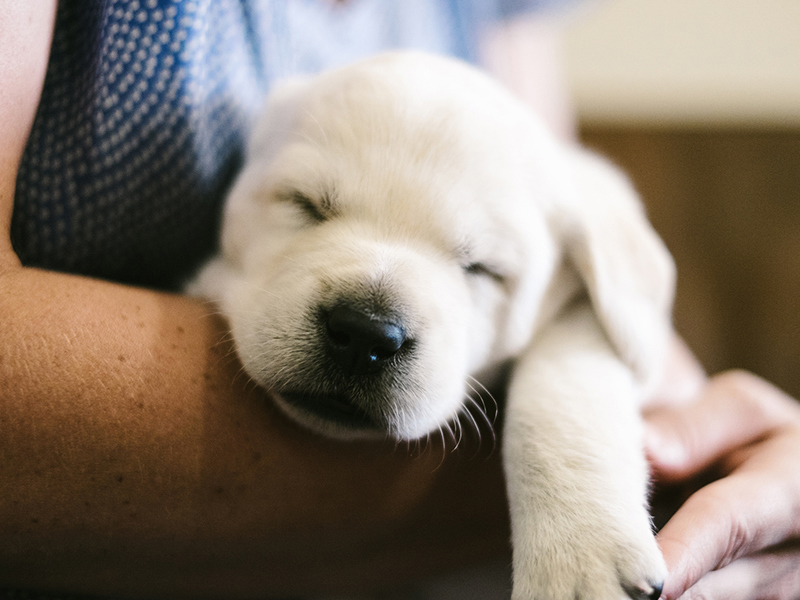
Bulldog
Breed characteristics
- Size
- Medium
- Exercise
- Up to 1 hour per day
- Size of home
- Small house
- Grooming
- Once a week
- Coat length
- Short
- Sheds
- Yes
- Lifespan
- Under 10 years
- Vulnerable native breed
- No
- Town or country
- Either
- Size of garden
- Small/ medium garden
About this breed
Bull baiting was introduced to Britain by the Normans in the 12th Century when they used mastiff-type dogs to torment bulls. By the 16th Century bull baiting was a popular ‘entertainment’ for all classes. The leggier mastiff types were replaced by smaller, thick-set dogs with strong heads and powerful jaws, these being the ancestors of the modern Bulldog.
In 1835 bull baiting was made illegal and the future of the breed, now without a function, was threatened. Those kept as companions provided the nucleus for the regeneration of the breed when dog showing became fashionable. The Kennel Club recognised the bulldog in 1873 and he remains the iconic British breed, thought to symbolise the spirit of the country.
Since the start of the 21st Century dedicated breeders have worked hard to improve the health of the breed by reducing exaggeration in the physical features. Changes to the Kennel Club Standard have militated against exaggeration with a strong focus on health and welfare. The Bulldog remains hugely popular as a family companion for his great character and loyalty.
Images for this breed
The Utility breed group
This group consists of miscellaneous breeds of dog mainly of a non-sporting origin, including the Bulldog, Dalmatian, Akita and Poodle. The name ‘Utility’ essentially means fitness for a purpose and this group consists of an extremely mixed and varied bunch, most breeds having been selectively bred to perform a specific function not included in the sporting and working categories. Some of the breeds listed in the group are the oldest documented breeds of dog in the world.
Colour Watch
Category 4: Breeds with >30% registered NBS colours or more than 1000 NBS registrations per annum
Breed Standard colours
Breed standard colour means that the colour is accepted within the breed standard and is a traditional and well-known colour in this breed.
Breed standard colours in this breed include:
- Brindle
- Brindle & White
- Fawn
- Fawn & White
- Fawn Brindle
- Fawn Brindle & White
- Red
- Red & White
- Red Brindle
- Red Brindle & White
- Red Fawn
- White
- White & Brindle
- White & Fawn
- White & Red
Non-breed-standard colours
- (NBS) Black
- (NBS) Black & White
- (NBS) Black & White with Tan markings
- (NBS) Black & Tan
- (NBS) Black & Tan with White Markings
- (NBS) Blue
- (NBS) Blue & Tan
- (NBS) Blue with White or Tan Markings or Patches
- (NBS) Blue Fawn
- (NBS) Blue Fawn with White Markings or Patches
- (NBS) Blue with White, Sable, Tan Markings
- (NBS) Brown
- (NBS) Brown with Tan Markings
- (NBS) Sable
- (NBS) Sable with Tan or White Markings
- (NBS) Cream
Non-breed-standard colour means that the colour is not accepted within the breed standard and whilst some dogs within the breed may be this colour, it is advised to only select a dog that fits within the breed standards for all points.
Colour is only one consideration when picking a breed or individual dog. Health and temperament should always be a priority over colour.
Other colour/s
'Other' means you consider your puppy to be a colour not currently known within the breed and one that does not appear on either the breed standard or non-breed-standard list. In this instance you would be directed through our registration process to contact a breed club and/or council to support you on identifying and correctly listing the new colour.
Health
Whether you're considering buying a Bulldog puppy or breeding from your dog, it's important to understand the health issues that may affect the breed and how they can be managed or avoided.
Pre-breeding health screening
Good Practice schemes and tests
We strongly recommend that breeders, at a minimum, conduct these tests before breeding, as evidence indicates these conditions are a significant concern in the breed.
- Breathing testing (for brachycephalic obstructive airway syndrome (BOAS)) using the KC Respiratory Function Grading scheme
- Eye testing using the BVA/KC/ISDS Eye Scheme
Best Practice schemes and tests
These tests address conditions that are still significant for the breed, though they may not be as critical as those listed under Good Practice. They might be less common or newly identified, and research is ongoing to determine their full impact.
To support the breed’s health, responsible breeders should ensure they complete all tests in both categories. Following our Best Practice guidelines means completing both the Good Practice and Best Practice tests for your breed.
- DNA test for hyperuricosuria (HUU) - Find lists of tested dogs here
- Elbow testing (for elbow dysplasia) using the BVA/KC Elbow Dysplasia Scheme
- Hip testing (for hip dysplasia) using the BVA/KC Hip Dysplasia Scheme
This breed also has a breed club health scheme, with further information available here
This breed can be affected by conformational concerns, more information can be found here
Find out about a particular dog's results
Please visit our Health Test Results Finder to discover the DNA or screening scheme test results for any dog on The Kennel Club's Breed or Activity Register.
You can also view the inbreeding coefficient calculation for a puppy's parents, or for a dog you're thinking of breeding from.
DNA testing services
To support your health testing journey, we offer a breed-specific package tailored to your breed's unique health needs. This package provides important information about potential health risks, helping you make informed decisions. Click here to find out more and access the tests relevant to your breed.
Breed health & conservation plan
The Breed Health and Conservation Plans
Our breed health and conservations plans (BHCPs) use evidence and data to help us understand the health issues found in each pedigree dog breed. These plans help breeders and owners identify health and welfare problems and use information, health tests and health schemes to avoid passing on those problems to future puppies. They also support and provide breeders with tools and specialist expertise to help manage genetic diversity, understand the impacts of close breeding, and find the best ways to preserve the population of their breed.
Working together for the breed
We’ve worked with breed clubs and breed representatives to gather all available evidence to help us determine the priority concerns for the breed and decide how we can work together to manage and reduce these problems.
Breed priorities
The current key priorities for the breed are:
- Brachycephalic obstructive airway syndrome (BOAS)
- Ocular conditions
- Cardiovascular conditions
- Skin conditions
- Obesity
How we plan to make improvements
We’ve agreed the following list of actions with the breed clubs to improve the health of the breed. Both parties are committed to working on these areas and will review these on a regular basis to ensure the actions remain focussed and relevant to the breed’s health.
Breed Club actions include:
- The Bulldog Breed Council and Breed Clubs to continue to actively encourage uptake of the BVA/KC/ISDS Eye Scheme. – IN PROGRESS (the breed is included as one of the five brachycephalic breeds that a team from the Royal Veterinary College are researching, offering free eye testing as part of their project)
- The Bulldog Breed Council and Breed Clubs to continue to encourage members to make use of the breed health scheme. – ONGOING
- The Bulldog Breed Health Representatives to continue to participate in the Brachycephalic Working Group with The Kennel Club’s support. – ONGOING
- The breed clubs to attend Bulldog owner events and share information to pet owners with regard to Bulldog health. – ONGOING
- The breed clubs to conduct a survey at shows using the body condition score chart, once available. – IN PROGRESS (The Kennel Club are currently exploring opportunities with researchers at the University of Cambridge and Royal Veterinary College, to develop this tool for the breed)
- The breed clubs to continue to encourage uptake of the Respiratory Function Grading Scheme, with a target to increase the number of dogs participating in the scheme, and provide details of health testing sessions to The Kennel Club. – ONGOING
Our actions include:
- To progress and fund a Bulldog specific body condition score with the University of Cambridge, with the breed clubs to assist in sourcing dogs. – IN PROGRESS (see action above)
- To report on progress made with the Veterinary Cardiology Society with regard to a heart scheme for Bulldogs/ pulmonic stenosis – IN PROGRESS (we have been discussing heart scheme development and data collation with the Veterinary Cardiology Society, and hope to hold screening days for a number of breeds over the coming years)
- To investigate the feasibility of developing certification for Bulldogs as part of the BVA/KC/ISDS Eye Scheme, with additional guidance to owners. – IN PROGRESS (see action above)
- To investigate research avenues for cherry eye with the Kennel Club Genetics Centre and BVA/KC/ISDS eye panel working party. – IN PROGRESS (see action above)
- To report back on the progress of the neurology development group. – IN PROGRESS (We are working with a specialist neurology working group to gain the expertise to determine the best way to develop a formal scheme to cover spinal problems in the breed)
- To assess the impact of current wording under the RFG Scheme for grade 2s – particularly with regard to the phrasing “clinically affected” – COMPLETE (this action was completed in 2020 and the guidance has been rephrased on The Kennel Club website)
- To develop a health survey, based on the Dachshund health & lifestyle survey, and disseminate to all registered owners of the breed – COMPLETE (this action was completed in 2022, with the survey results to be included in the next Breed Health and Conservation Plan update)
- To investigate research avenues for skin conditions that impact the Bulldog.
The full evidence base is available at the discretion of the breed clubs, however if you would like to seek access to the full report, please contact our health team here.
Health (The Kennel Club)
How do I use this information?
Breeders should be mindful of the top priorities in their breed and ensure they are working to reduce and eliminate the presence of these diseases when choosing to breed their dogs.
Puppy buyers should also be aware of these issues and be sure to ask their breeder how they are contributing towards the above actions, and whether any of these problems have been seen in their breeding lines.
More about health
Have any questions about health in your breed?
If you have any concerns about a particular health condition in your breed then you may wish to speak to your vet or you could contact your breed health co-ordinator.
Breed health co-ordinators are individuals working on behalf of breed clubs and councils who are advocates for the health and welfare of their chosen breed. They acts as a spokesperson on matters of health and will collaborate with The Kennel Club on any health concerns the breed may have.
To contact your breed health co-ordinator please email
Health (The Kennel Club)
Health issues in flat-faced dogs
Dogs with a flat, wide-shaped head, are said to be brachycephalic (brachy, meaning short and cephalic, meaning head). This particular skull shape will often give these dogs a characteristic flattened face and a short muzzle. Although the shape of these dogs’ heads can make them look very cute, dogs with a very flat face and short muzzle have a higher risk of developing certain health issues associated with their features. Some of these issues are outlined below, but for more information on the health and welfare of flat-faced dogs, visit our brachycephalic hub.
Breathing difficulties
The soft tissue in the nose and throat of some brachycephalic dogs may be excessive for the airways, making it difficult for them to breathe normally (causing heavy panting or noisy breathing). Some dogs may also have narrow nostrils making it even more difficult to breathe.
More information can be found:
- in our film about breathing problems in flat-faced dogs
- from the University of Cambridge website
- within our article on breathing problems in flat-faced dogs
Skin problems
Some brachycephalic dogs may have an excess of skin, which creates folds, especially around the front of the face. These folds can make a warm, moist environment which is perfect for bacteria and yeast to grow, possibly leading to infection and severe itching.
More information can be found in our article on skin problems in flat-faced dogs.
Teeth problems
Dogs with a shortened skull will often have a shortened jaw, but the number and size of teeth will stay the same. This can mean that the teeth become overcrowded and can cause dental and gum problems.
More information can be found on our advice page on how to take care of your dog's teeth.
Eye conditions
Some brachycephalic dogs may have shallow eye sockets, causing their eyes to become more prominent and at a higher risk of trauma, ulcers and increasing the chance of them becoming dry and painful (due to not being able to blink properly).
More information can be found in our article on eye problems in flat-faced dogs.
Breed watch
Category 3
Particular points of concern for individual breeds may include features not specifically highlighted in the breed standard including current issues. In some breeds, features may be listed which, if exaggerated, might potentially affect the breed in the future.
Breeding restrictions
There are a number of The Kennel Club rules and regulations that may prevent a litter from being registered, find out about our general and breed specific breeding restrictions below.
More about breeding
The Kennel Club does not accept the registration, including any imported dogs, of any merle Bulldogs.
Merle patterning - patches of lighter colour appearing in the coat - is the result of the M gene in the dog. There are two alleles of this gene: M (merle) and m (non-merle), with merle (M) being dominant to non-merle (m). In some breeds, the effect of the merle allele (M) is termed ‘dapple’. Unfortunately, the effects of the merle allele (M) are not confined to coat patterning and it is known that there can be an increased risk of impaired hearing and sight associated with it, particularly in dogs that are homozygous for M (dogs that carry two copies of the M allele).
As the merle colour is not a naturally occurring colour in this breed, and in view of the health concerns relating to the merle gene, The Kennel Club will not accept the registration of any merle Bulldog puppies.
Looking for a puppy?
Looking for a Bulldog? Explore our list of puppies and rescue dogs for sale near you.
More information

Need to find out more about a breed?
Use our Find a Club service where you can locate breed clubs that can offer support and advice.

Use our Find a Puppy service
The Kennel Club's Find a Puppy service provides contact details for breeders who have puppies available. Let's help you find your new best friend.

Get the best lifetime pet insurance
At Kennel Club Pet Insurance, we want you to focus on getting the best possible treatment for your dog without worrying about the cost.
